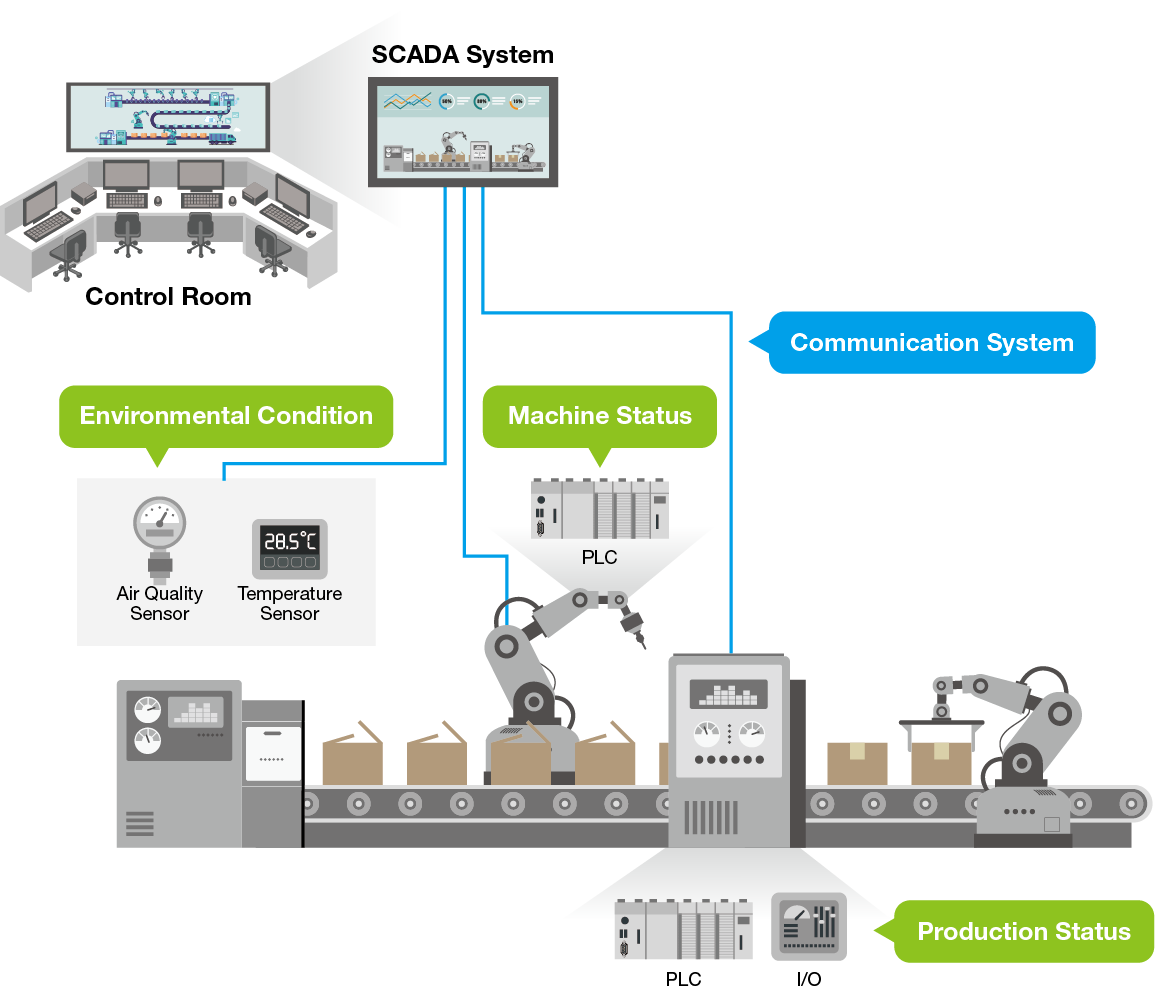Thanks to the advancements in technology that unlock the potential of Industry 4.0, factory operators are dedicating increased resources to the enhancement of intelligent factories for improved operational efficacy. A recent analysis revealed that the intelligent factory market is poised to expand by 9.33% during the forecast span from 2021 to 2026. However, before businesses can enjoy the advantages of smart factories, operators must attain visibility of the production floor. This necessitates the deployment of additional sensors and systems at production lines to enable engineers to gather ample information, craft analytics, and ultimately implement suitable measures to enhance efficiency.
To create a comprehensive perspective for your production lines, a variety of information types are required. For example, understanding the production status of each production line provides insights into its performance and identifies any potential or existing bottlenecks. By supervising the real-time production process, you heighten the likelihood of averting potential downtime and boosting productivity. Moreover, monitoring the operational state of machines aids in scheduling maintenance tasks without unforeseen setbacks. Furthermore, integrating additional sensors into production lines to record temperature and humidity data aids in reducing interruptions due to environmental factors.

Irrespective of the kind of data you intend to gather to realize the objectives of your ideal smart factory application, ensuring seamless communication between production lines and the control center can pose significant challenges for engineers. Without a dependable connection and a robust network established between remote sites and the control center, operators are unable to access complete and accurate data for comprehensive planning and optimization of operational efficiency. Here are several recommendations you may contemplate when enabling connectivity for your production lines.
Thoroughly Assess Your Connectivity Needs
When initiating connectivity for your production lines, it is crucial to ascertain the communication interfaces and protocols utilized by your field devices, as well as the systems they need to interface with. The following three scenarios are frequently observed during commencement.
- Retrieve operational data from legacy devices. Your legacy machinery is customarily engineered to serve production functions reliably in your facilities for years, yet they frequently lack network interfaces, or come equipped solely with legacy communication interfaces like serial. Utilize sensors to capture production data for devices lacking communication capabilities or consider a serial-to-Ethernet solution to extract data from legacy devices.
- Monitor production status from the control center. Production lines are typically managed by engineers through a PLC and HMI situated at the field location. When the central system also needs to supervise and regulate your production lines, it must comprehend and communicate with the field PLC and HMI. However, machine vendors often adopt communication protocols that may not align with SCADA systems. Such instances necessitate a protocol conversion solution to facilitate communication between the SCADA system and the field-based PLC and HMI.
- Mitigate influence from environmental factors. Various types of sensors can be deployed to assess environmental conditions, such as temperature, humidity, and air pressure. These sensors are equipped with myriad I/O interfaces, and you require a remote I/O solution capable of seamlessly collecting data. Additionally, consider the supported protocols of your remote I/O solution and select one that aligns with your SCADA system.
Regardless of the scenario encountered, there will be a multitude of connectivity requisites that must be fulfilled before data can be acquired to enhance your operational efficiency. It is imperative to meticulously weigh the connectivity options at your disposal and opt for one that not only establishes connectivity between your devices and systems but also ensures smooth communication with minimal maintenance demand.
Implement a Dependable and Adaptable Network for Real-time Monitoring
Facilitating a smarter production line necessitates heightened network capacity and superior visibility. While devising your network communication strategy, meticulously appraise your demands regarding transmission bandwidth, network control capabilities, and manageability for each network node. Firstly, gauge your network bandwidth needs. Connected production lines typically deploy numerous sensors and systems that generate significantly increased data volumes. Managing vast data volumes not only mandates ample transmission bandwidth but also requires redundancy to prevent packet loss due to unforeseen network outages.
Secondly, your networking tools must support communication protocols at both the field location and the control center for engineers to monitor and act promptly in real time. Also, if you are building adaptive production control systems or encompassing time-critical processes in your production lines, contemplate establishing your networks based on time-sensitive networking (TSN), the standard Ethernet integrated framework, to transmit your directives accurately and promptly.
Lastly, integrating numerous network devices translates to extensive installation and upkeep demands. This aspect warrants thoughtful consideration, as you must pinpoint an efficient solution streamlining your network management.
Do Not Disregard Cybersecurity Threats
The surging frequency of cyber assaults targeting industrial applications in recent times has elevated the significance of cybersecurity. A recent examination indicated that 4 out of 10 manufacturers noted their operations were affected by a cybersecurity event in the preceding year. Threats are omnipresent, encompassing unauthorized access, unwarranted programs, and denial-of-service attacks that could disrupt a production line. To mitigate security concerns, the initial step involves verifying the security level of your networking devices. Employ a checklist to ascertain if you are selecting a product inherently secure. Moreover, network segmentation is essential to impeding threat propagation should an actual cyberattack occur. Above all, bear in mind that security is a continuous journey, not a one-off event. Regularly scrutinizing your devices and security status and conducting vulnerability assessments can offer enhanced control over your security posture prior to necessitating mitigation.
As a distinguished authority in industrial networking, Moxa has assisted clients globally in establishing seamless and secure communication to regulate and scrutinize their production lines. Access our case studies to witness how other enterprises have formulated communication systems for their production lines using Moxa’s solutions.
In need of guidance on selecting connectivity or networking products for your initiative? Download our E-book to gain insights into the key criteria for selecting the appropriate products for your requirements.
- Not Only for Automobiles: Discovering CANbus Technology in Various Industrial Settings - October 29, 2024
- Boost Your Network Performance: An Exciting Manual to PoE Switches! - September 10, 2024
- Understanding Gigabit Switches: Industrial vs Regular Gigabit - September 4, 2024


